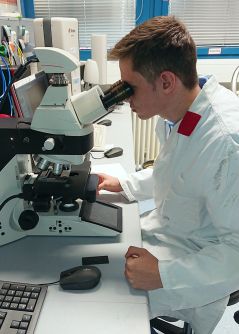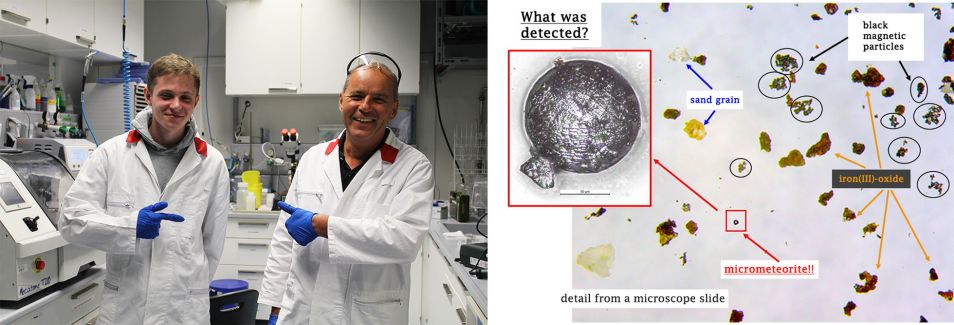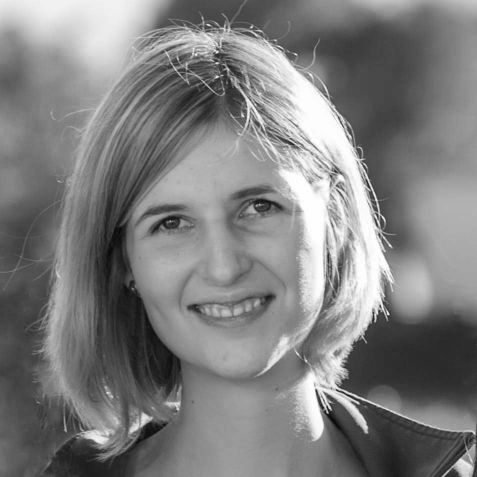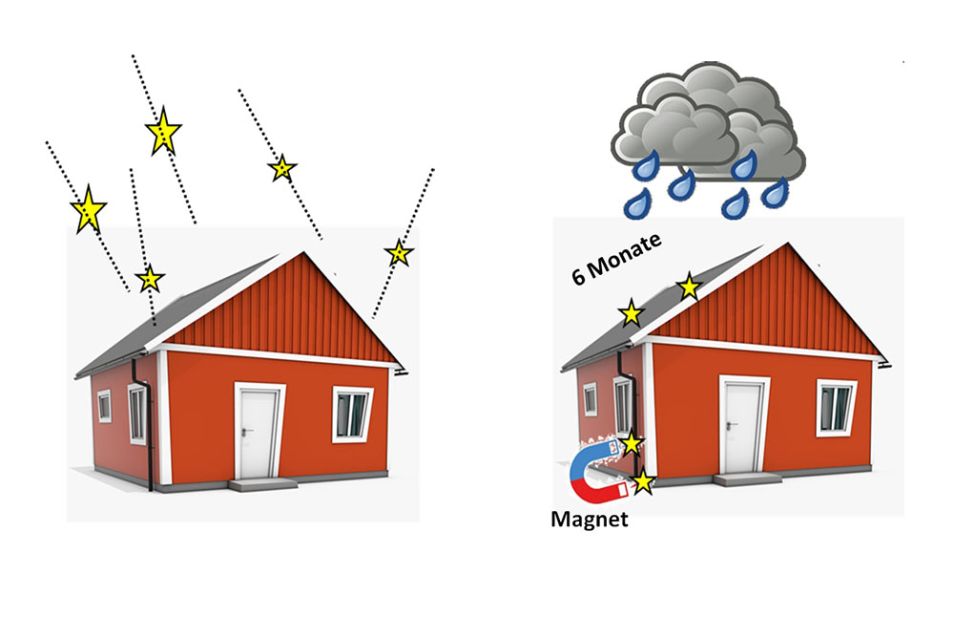MLZ is a cooperation between:
 > Technische Universität München
> Technische Universität München > Helmholtz-Zentrum Hereon
> Helmholtz-Zentrum Hereon
 > Forschungszentrum Jülich
> Forschungszentrum Jülich
MLZ is a member of:
 > LENS
> LENS > ERF-AISBL
> ERF-AISBL
MLZ on social media:

MLZ (eng)
Lichtenbergstr.1
85748 Garching
Shooting stars from the gutter
Philipp Meven sits at the microscope in deep concentration, his eyes focused on the eyepiece. The 15-year-old pupil is counting meteorites. More precisely, micrometeorites that he collected from the rooftop of his parent´s house during the last six months.
”Philipp prepared his one week internship project very conscientious,” Armin Kriele, technical manager of the Materials Science Lab at MLZ, commends. The method was remarkably easy: positioning a magnet in a gutter and regularly wrapping it with new cellulose paper. This paper then dissolves completely in acetone thereby releasing all captured magnetic particles having been washed away from the rooftop by the rain.
Research method: looking carefully
“Micrometeorites, or tiny shooting stars, result, when heavenly bodies collide in space,” Philipp explains. Entering the earth´s atmosphere, the small messengers from the universe melt and receive their round, shiny and smooth surface, and a special inner crystal structure. “By this they can be distinguished very well from all the other particles under the microscope,” the student from the Humboldt-Gymnasium Vaterstetten elaborates. He knows exactly what he is talking about. For three days, he sorts and measures the in total 18,800 particles that he collected with the magnet. Then, Philip proudly presents the surprising result: amongst the particles, there are indeed eight micrometeorites. An X-ray structure analysis shows that four amongst them are iron-nickel and two are obsidian meteorites.

For three days Philipp Meven, intern at the Materials Science Lab of MLZ, is sitting at the optical microscope. In his research project the student searches and analyses micrometeorites. © MLZ / TUM
We are all made of stardust…
With their size, micrometeorites are comparable to the thickness of a hair. “They are so small, probably you even inhale them,” Armin Kriele states. After a little estimation-bet Philipp makes a rough calculation for fun: a human probably inhales six shooting stars as fine dust during his life-time.
Mysterious black particles
Afterwards Philipp takes a keener look onto an unexpected discovery: amongst the collected particles there are numerous mysterious black particles. At the Materials Science Lab, they do not give up so easily, and an X-Ray analysis finally unmasks the cryptic pieces: they consist of magnetite. Nevertheless, where exactly the mineral comes from and how it could get on Philip´s rooftop in Baldham remains unsolved. “This way, results generate new questions,” Kriele states. He and Philipp agree: “In research this provides variety.”
One clearly realizes how much fun Armin Kriele himself has with the internships and research projects that he has been offering at his laboratory for some years now. Giving young people the possibility to gain an insight into science and offering a chance for those who otherwise would not get the opportunity for a comparable internship is a special concern for the physicist.
Much more exciting than in school
Philipp himself shares his special interest in science with his father. Dr. Martin Meven is an instrument scientist at MLZ and responsible for the single crystal diffractometer HEiDi. “I often participated in the TUM holiday program next to the FRM II, so I already knew a bit about the reactor,” Philipp explains his idea for the internship. For him, the week at MLZ was clearly worth it. “The meteorite project at the laboratory was very interesting and more exciting than in school,” Philipp sums up his internship. There could certainly be no better evaluation for his supervisor.

Left picture: A good team in the laboratory: Philipp Meven (l.) and his supervisor Armin Kriele (r.) © MLZ / TUM Right picture: Taking a look to the microscopic image: micrometeorites have a mostly perfect round shape. With their light reflection, they thus differ well from all the other pieces. But what about the black particles? © MLZ / TUM
Also interesting:
Laboratory internship between predators and ruminants
Felicia Nachbar, student at the Oskar-Maria-Graf Gymnasium in Neufahrn, examines the teeth of predators and ruminants. The 14-year-old does a voluntary internship at the Materials Science Lab of the Heinz Maier-Leibnitz Zentrum in Garching, a laboratory for sample preparation and x-ray analysis.

Teresa Kiechle
Press & Public Relations
FRM II
MLZ is a cooperation between:
 > Technische Universität München
> Technische Universität München > Helmholtz-Zentrum Hereon
> Helmholtz-Zentrum Hereon
 > Forschungszentrum Jülich
> Forschungszentrum Jülich
MLZ is a member of:
 > LENS
> LENS > ERF-AISBL
> ERF-AISBL
MLZ on social media:




